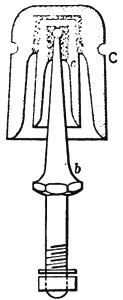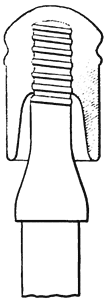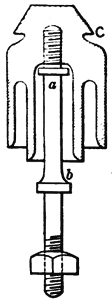[Trade Journal]
Publication: The Electrician & Electrical Engineer
London, England
vol. 4, no. 2, p. 44-45, col. 1-2
THE CONSTRUCTION OF LINES FOR ELECTRIC CIRCUITS.
BY THOMAS D. LOCKWOOD.
(Continued from page 5.)
INSULATORS AND INSULATION.
IN the construction of electric lines, it is utterly impossible to bestow too much care upon the insulation of the conducting wires. To my mind, one of the most wonderful and valuable discoveries in electrical science, was that of Stephen Gray; viz.: the fact, that while some substances will readily conduct electricity, others oppose in a marked degree such conduction. It is I think this discovery more than all others that rendered electric telegraphy possible. Such substances as conduct easily, we call "conductors."
Substances which offer a high resistance to the passage of electricity, are called "non-conductors" or "insulators." It is absolutely impossible to insulate wires too well, when they are to be used in telegraphy. Defective insulation is a sufficient cause to mar completely the efficiency of an otherwise well built line, fitted with the most perfect instruments, and supplied with abundance of battery or machine power. No substance known is absolutely a nonconductor, and it is therefore quite impossible to provide an absolutely perfect insulation; the best we can do therefore is to limit the escape of the electricity, and prevent it from exceeding certain bounds. Constructors of electric lines are doubtless well acquainted with the reasons for interposing insulating substances between the line wire and its points of support, yet a careful observation of many lines which come under our notice, indicates too surely, that if the constructors of such lines know, they at least "don't care"; since some of the insulators employed, and some of the methods of employing them, exhibit a lofty contempt for the laws of electric conduction, and an apparently deep-rooted idea, that the sole reason for the use of insulators real or alleged, is that we may have something hard and round, with a groove in it, for the wire to be fastened to.
In the choice of a suitable insulator several points demand our consideration.
First: the material of the insulator. Second: the form of the insulator. Third: the attaching appliances, and the method of attachment.
As to the material—glass, hard rubber, and porcelain or earthenware, are now, in some form, almost exclusively used, and kiln-dried or otherwise prepared wood is employed to some extent.
To obtain a material for an insulator, which is in every respect the best, is almost as difficult as to obtain a voltaic cell which combines all the conditions of perfection. The desideratum, is to obtain a material which as nearly as possible offers an infinite resistance to the passage of electricity; which does not readily conduct heat; which is non-porous, and has a surface which is and will remain smooth and free from cracks. It should not deteriorate when exposed to the weather, and should be a non-absorbent of moisture. No material has as yet been found which is free from all objection. There is also one more qualification which enters in a very marked manner in the choice of material in America—that is " cost"—it must be cheap— or it will not be considered.
Glass demands the first place, since in America it is almost universally employed. It meets many of the above conditions—being of high resistance—non-porous, non-absorbent, and readily obtainable of smooth and permanent surface. On the other hand it is a fair conductor of heat, and condenses the moisture upon its surface very readily, and is moreover very brittle and thus particularly defenceless with reference to the attacks of the small boy. In the climate of England, the surface of a glass insulator is almost always covered with a film of moisture to a greater or less degree, and therefore glass is not in that country preferred. In the United States where the climate is drier, this trouble has not proved sufficiently grave, to counterbalance its many advantages, and glass is accordingly used, more than any other material.
When insulators are well made of the best glass, and are rightly shaped, they give in a reasonably dry climate very good results, and if proper methods of testing were invariably adopted, and all insulators found faulty thrown out, the average of insulation would be greatly improved.
Hard rubber is used to a considerable extent in city and short line work, and is in the form of the well-known rubber hook, well adapted for covered wire or bare wire not over No. 12 B. W. G. also for soft copper loops. It has many good features: high resistance, strength and convenience. Its defects for this purpose, are its comparatively high cost, and also the rapid deterioration of its surface, which, when exposed to the weather soon becomes rough, and spongy, after that it has a tendency to gather and accumulate dirt and moisture, and its insulating properties are a thing of the past.
Porcelain is the material chiefly employed at the present time in England and European countries. It is a good insulator, is easily moulded into the desired shape, has a good smooth surface, and properly manufactured gives satisfaction. Unless however the manufacturer can be depended on, the porcelain insulator is treacherous, holding out, if defective in mass only until the external glaze cracks. When it is good, it is very good—and will no doubt continue to be used extensively in England. It is not a cheap material and this together with the fact that glass is found to answer, have kept it from general use in America.
Earthenware has been much used but its employment is diminishing in extent —its chief advantage is cheapness. The form of the insulator is of equal importance with the material. Why? Because though an insulator when compared with the material of the line conductor, it is none the less a conductor, when considered specifically; and as a conductor it is amenable to the law of conductors; that is, the less the diameter and the greater the length of the surface, the greater is the resistance exposed to the escape of the current. This teaches that we should make the insulator of such a form, as to bring a considerable length of surface between the point where the wire is supported, and the point at which the insulator itself is affixed to the pin or bracket; while it should also be made so as to expose very little width of surface between the same points. Another point also requires some attention in making insulators which meet the above requirements, the necessary quality of strength must not be overlooked.
The insulator shown in figure 3 below, is now much used in England and is well adapted for insulating purposes, on account of the great length of the surface between the wire and the pin. It consists of two cups, one inside the other; the inner cup c is fixed to the outer cup c, by cement, and the bolt b, is cemented into the inner cup.
 |
| Figure 3 |
The glass insulator used in the United States is by no means so perfect as regards form. It is shown in the figure below; and has but one cup, furnished with a skirt which overhangs the surface of the pin. The length of surface is much less than the English form, and escape is proportionately easy. Could we obtain the glass insulator provided with the concentric cup, insulation would be improved.
An attempt has recently been made to improve the American insulator in this respect, by slitting the thread which screws on the pin vertically, so that less surface is presented to the pin.
A variety of porcelain knob has been used to some extent of late years as a pole insulator. It consists merely of a short porcelain knob of cylindrical form, and having a countersunk wood screw hole extending through it. It is fastened on with a single screw which passes through this hole. It is hardly worth calling an insulator, although some telephonic constructors of sanguine and imaginative temperament have used it in that capacity. Neither size nor shape is adapted for such a purpose. The knob was made to serve as an attachment, for use especially in protected places to which covered wires might be fastened. As an attachment it is all right. As an insulator it is worthless.
ATTACHING APPLIANCES.
The English porcelain insulator has until quite recently been cemented, in the way shown in figure 3, to the head of an iron pin, the pin being furnished with a heavy bolt at its lower end, this being adapted to pass through the cross arm, and to be held by a nut on the lower side. Cements in insulators are always bad, and this arrangement has not been satisfactory. Recently an improvement has been introduced, substantially the same in effect with the screw attachment which we in America have so long utilized.
The way it is applied to the English insulator is clearly shown in figure 5.
 |
| Figure 4 |
The ordinary method of attaching the insulators in this country is indicated by figure 4, and is simply to mould a thread in the hollow or cup of the insulator, to cut a corresponding thread on the pin which is of wood, and to screw the insulator into place on the pin. A remarkable patent was taken out last spring for what was entitled "Means for Insulating and Supporting Electrical Wires." The alleged insulator comprises a block of wood, notched like a clothes pin to some depth, and having in some instances a flat surface for nailing to poles, and in others, a wedge-shaped end to drive in holes bored in cross arms. The block may be nailed through its solid part to the pole; a sheet of pliable india-rubber or some such material is doubled and placed in the slit, and the line wire is slipped up between the two surfaces of the rubber. The free or open ends of the slitted block, are then to he nailed together and to the pole, clamping the wire. This is said to give excellent insulation and to be very cheap.
 |
| Figure 5 |
We are reminded of an anecdote of the late French General Bosquet; who, it is said, after watching the British Light Brigade, 600 strong, charge the entire Russian army at the Crimea, remarked "This is magnificent, but it is not war." So with respect to this device we are constrained to say: "It may be neat, it may be cheap, it may be durable, hut it is not an insulator." The American constructor will do well to stick to glass and bracket for a while longer.
Insulators should be attached where they can be well washed with every heavy rain. They should never be attached horizontally or below a cross arm because in that case the water from rain flows in, and makes a first-class conducting surface to the pole. Hook insulators especially should never be placed with the petticoat upwards. A short line does not need the extreme care in the choice of, and attachment of insulators that is essential to the good working of a long one. A single telephone line will often work clearer during the transmission of conversation when it is slightly leaky, provided the leakage is uniform; and it is indeed surprising to note, how little the telephone depends upon insulation.
As we cannot however maintain a uniform leakage - and as moreover we need a well insulated line to send call signals over, it is found more satisfactory on the whole to insulate the line well; especially when more lines than one are extended on the same poles, because in that case the leaking currents pass into other wires disturbing and confusing the passing messages. A great deal of the alleged induction between telephone wires, is without doubt due to direct leakage between wire and wire.
The excellence of the insulation of a line depends upon several conditions: The material and form of insulator, the number of supports per mile, and the size of the conducting wire, all have their share in determining this function.
According to Culley, insulation should never fall below 200,000 ohms per mile in wet weather.
